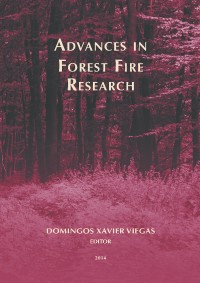Please use this identifier to cite or link to this item:
https://hdl.handle.net/10316.2/34353| Title: | Modeling fire behaviour and carbon emissions | Authors: | Groot, William J. de Cantin, Alan S. Jurko, Natasha Newbery, Alison |
Keywords: | Canadian Fire Effects Model;Crowning;Fire intensity;Forest carbon;Fuel consumption;Rate of spread;Wildland fire emissions;North American forest regions;Circumpolar boreal forest | Issue Date: | 2014 | Publisher: | Imprensa da Universidade de Coimbra | Journal: | http://hdl.handle.net/10316.2/34013 | Abstract: | Wildland fire is an important component of the earth system and global carbon cycle, burning about 350 M ha of vegetated land and contributing 2.0 Pg C to the atmosphere in direct emissions every year. Wildland fire carbon emissions are directly related to fuel consumption, which is a key component of fire behaviour. Fuel consumption varies greatly by fuel (vegetation type, load, size, spatial distribution, moisture content) and weather (temperature, relative humidity, wind speed, rainfall) parameters. In forested regions where wildfires may burn for extended periods of time, carbon emissions can vary by an order of magnitude between stands within a single fire due to complex fuel structures and distribution patterns, and constantly changing fire weather conditions. Modelling stand-level fire behaviour and carbon emissions and compiling simulation results over large areas is commonly used as a bottom-up approach to summarizing fire regimes and estimating wildland fire emissions at large scales. This paper presents a summary of studies simulating stand-level fire behaviour and carbon emissions using the Canadian Fire Effects Model (CanFIRE). CanFIRE simulates fire behaviour in standing timber, grass, and slash vegetation types, or combinations of these vegetation types. In standing timber vegetation types, the forest stand is simulated as 3 distinct fuel components: forest floor (herbaceous plant, litter and organic soil layers), surface fuels (dead woody debris), and overstory (tree) fuels. Modelled fire behaviour and carbon emission results from studies in various global regions of different vegetation types and climate zones are presented, including comparisons using different fuels and weather/climate datasets and comparison to other carbon emission estimation methods. Sensitivity of the model outputs to driving input variables is presented. In particular, the influence of stand composition, structure, surface fuel load and distribution, and organic soil characteristics are reviewed. Annual and seasonal trends in fire behaviour and carbon emissions are also presented. Recommendations for basic data standards to provide reliable and consistent modelling results are discussed. | URI: | https://hdl.handle.net/10316.2/34353 | ISBN: | 978-989-26-0884-6 (PDF) | DOI: | 10.14195/978-989-26-0884-6_132 | Rights: | open access |
| Appears in Collections: | Advances in forest fire research |
Files in This Item:
| File | Description | Size | Format | |
|---|---|---|---|---|
| 978-989-26-0884-6_132.pdf | 1.5 MB | Adobe PDF |  |
Items in DSpace are protected by copyright, with all rights reserved, unless otherwise indicated.
